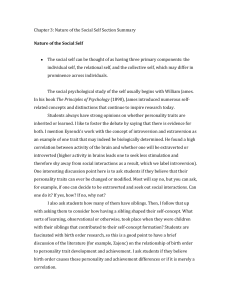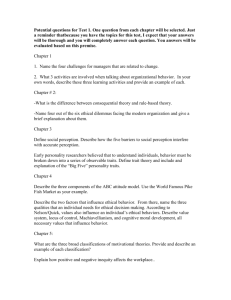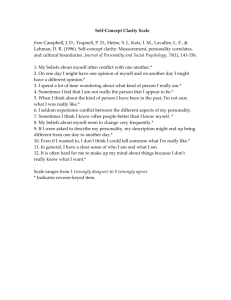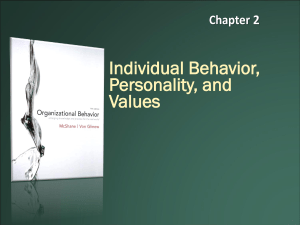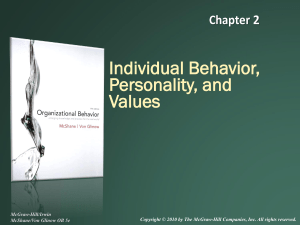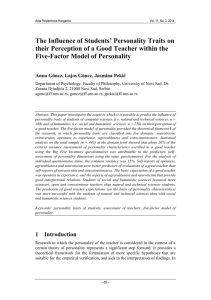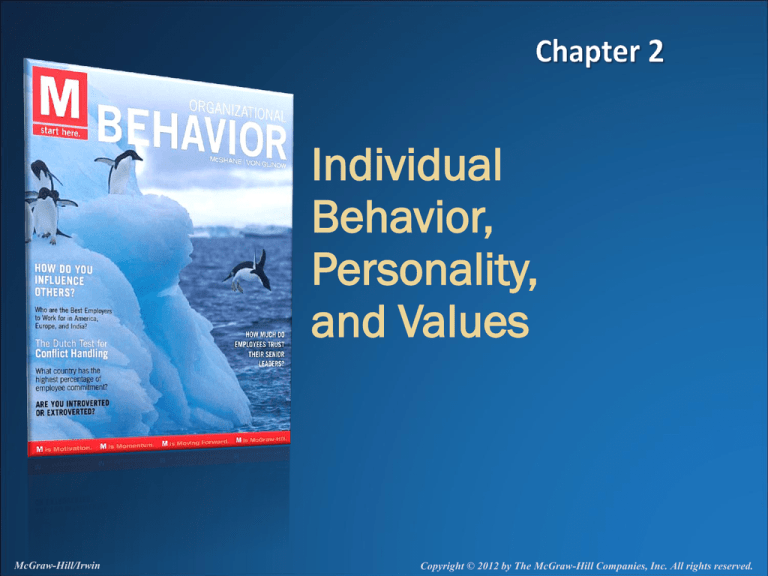
Individual
Behavior,
Personality,
and Values
McGraw-Hill/Irwin
Copyright © 2012 by The McGraw-Hill Companies, Inc. All rights reserved.
MARS Model of Individual Behavior
Situational
factors
Values
Motivation
Personality
Perceptions
Emotions
Ability
Individual
behavior and
results
Attitudes
Stress
Role
perceptions
2-2
MARS Model Elements
Motivation
• Internal forces that affect a person’s voluntary choice of
behavior
Ability
• Natural aptitudes and learned capabilities required to
successfully complete a task
Role perceptions
• Beliefs about what behavior is required to achieve the
desired results
Situational Factors
• Environmental conditions beyond the individual’s short-
term control that constrain or facilitate behavior
2-3
Defining Personality
Relatively enduring pattern of thoughts,
emotions, and behaviors that characterize a
person, along with the psychological
processes behind those characteristics
• External traits – observable behaviors
• Internal states – thoughts, values, etc inferred from
behaviors
• Some variability, adjust to suit the situation
2-4
Five-Factor Personality Model (CANOE)
Conscientiousness
Careful, dependable
Agreeableness
Courteous, caring
Neuroticism
Anxious, hostile
Openness to Experience
Sensitive, flexible
Extraversion
Outgoing, talkative
2-5
Five-Factor Personality and
Organizational Behavior
Conscientiousness and emotional stability
• Motivational components of personality
• Strongest personality predictors of performance
Extroversion
• Linked to sales and mgt performance
• Related to social interaction and persuasion
Agreeableness
• Effective in jobs requiring cooperation and helpfulness
Openness to experience
• Linked to higher creativity and adaptability to change
2-6
Myers-Briggs Type Indicator (MBTI)
Extroversion versus introversion
• similar to five-factor dimension
Sensing versus intuition
• collecting information through senses versus
through intuition, inspiration or subjective sources
Thinking versus feeling
• processing and evaluating information
• using rational logic versus personal values
Judging versus perceiving
• orient themselves to the outer world
• order and structure or flexibility and spontaneity
2-7
Self-Concept Definition and Elements
An individual’s self-beliefs and self-evaluations
• Guides individual decisions and behaviour
Three C’s of self-concept
1. Complexity -- People have multiple self-concepts
2. Consistency -- similar personality and values across
multiple selves
3. Clarity -- Clearly and confidently described, internally
consistent, and stable across time.
2-8
Four “Selves” of Self-Concept
Self-enhancement
• Promoting and protecting our positive self-view
Self-verification
• Affirming our existing self-concept
Self-evaluation
• Evaluating ourselves through self-esteem, self-
efficacy and locus of control
Social self
• Defining ourselves in terms of group membership
2-9
Schwartz’s Values Model
Openness to change – motivation
to pursue innovative ways
Conservation -- motivation to
preserve the status quo
Self-enhancement -- motivated by
self-interest
Self-transcendence -- motivation to
promote welfare of others and
nature
2-10
Values and Behavior
Habitual behavior usually consistent with
values, but conscious behavior less so
because values are abstract constructs
Decisions and behavior are linked to values
when:
• Mindful of our values
• Have logical reasons to apply values in that
situation
• Situation does not interfere
2-11
Values Across Cultures
Individualism
• Value personal freedom, self-sufficiency, control over
themselves, being appreciated for unique qualities
Collectivism
• Value group membership and harmonious relationships
within the group
Power distance
• Value/accept unequal distribution of power in a society
Uncertainty avoidance
• Value/tolerate ambiguity and uncertainty (low UA) or feel
threatened by it (high UA)
Achievement-nurturing
• Value value assertiveness, competitiveness, and materialism
(achievement) vs. human interaction and caring (nurturing)
2-12
Three Ethical Principles
Utilitarianism
Individual
Rights
Distributive
Justice
Greatest good for the greatest number
of people
Fundamental entitlements
in society
People who are similar should receive
similar benefits
2-13
Influences on Ethical Conduct
Moral intensity
• degree that issue demands ethical principles
Ethical sensitivity
• ability to recognize the presence and determine the
relative importance of an ethical issue
Situational influences
• competitive pressures and other conditions affect
ethical behaviour
2-14


